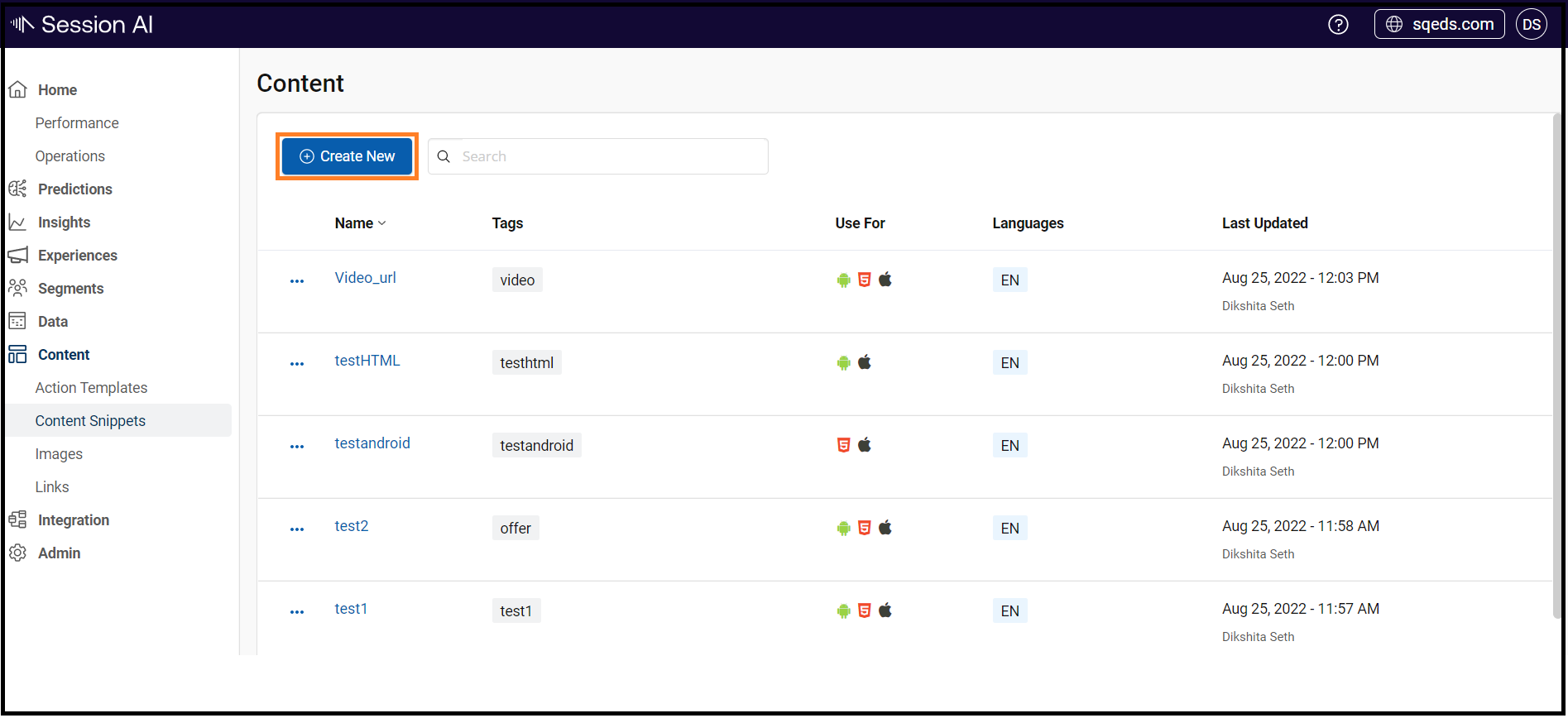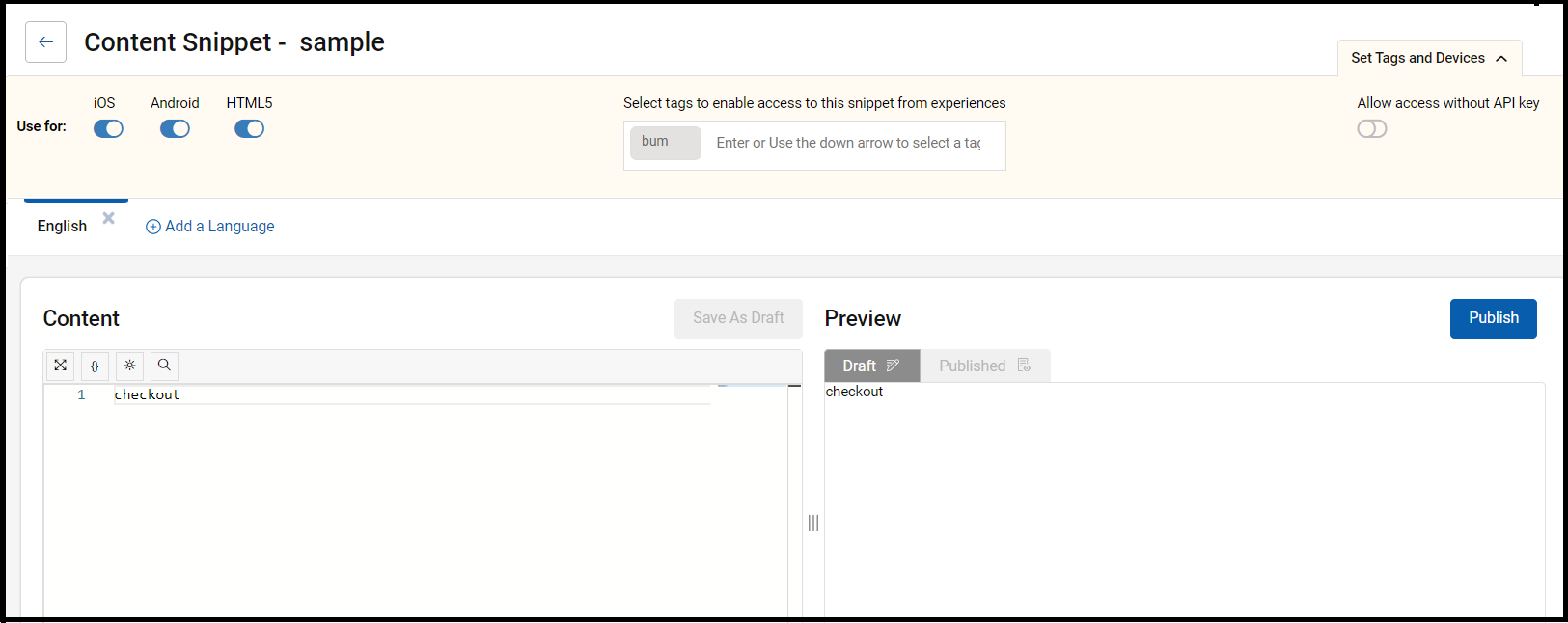Creating Content
What is Content?
Content is a piece of information or data used in various types of notifications delivered to customers. You can add one of the following contents:
- Text
- Content URL
- Image URL
- Video URL
What is a Tagged Content?
Tags are labels or keywords assigned to a piece of content. Tagging enables the system to access the most relevant content. Session AI dynamically uses the most relevant content that matches the specified tags.
Querying Method
Currently, Session AI supports the Best Match querying approach for matching tags. The most matching content with the tag is the best match.
The syntax to find the best matching content is [[tag://tag1,tag2]].
For example, you create the following content with the mentioned tags for the weather and sports categories, respectively:
Content Name | Tags |
|---|---|
Monsoon Offer | rain, swim |
Golf Club | sunny, golf |
Summer Fun | sunny |
Monsoon Tennis Tournament | rain, tennis |
Let us create a banner to demonstrate the matching of content with tags.
Use the Best Match condition, [[tag://${weather},${sport}]]:
- Content tag search with tags: weather = sunny, sport = cricket, will give you the match value as Content3 as it has sunny tag.
Best MatchIn the Best Match condition, the match value content result is any of the tags defined in the contents. The result must be ranked based on the closest match.
- Content tag search with tags: weather = sunny, sport = cricket, will give you the match value as Summer Fun since it has the sunny tag.
- Content tag search with tags: weather = sunny, sport = golf, will give you the match value as Golf Club since it has the sunny tag.
- Content tag search with tags: weather = rain, sport = ski, will give you no matching value since there is no tag such as ski added in any of the defined content.
- Content tag search with tags: weather = rain, sport = null, will give you the match value as either Monsoon Offer or Monsoon Tennis Tournament since they both have the rain tag.
NoteIf the content does not match the tag condition, then the interaction does not display any content.
The Session AI platform allows you to manage all content existing in the system. You can provide public access to the content as well as enforce access control on desired content when adding in the Interactions.
Add a New Tagged Content
- Log in to the Session AI platform and click the Content menu.
- In the Content menu, click Content Snippets.
The Content screen displays all the existing content. - Click Create New located in the upper-left corner.

The Content Snippet screen appears.
4. On the screen, enter the following details:
- Unique Name: Enter the title for your content.
- Use for: Enable/Disable the device type
- Select tags to enable access to this snippet from experiences: Enter the appropriate tag for the content and press Enter key. The tag is listed in the text box. Repeat this step to add more tags.
- Allow access without API key: Enable the icon to make the content available for public access.
- In the Content library, enter the desired content and/or select the desired settings for the added content.
- Click Save As Draft.
The newly added content and its settings appear on the Preview screen.

NoteThe content for URL, Image URL and Video URL type appears on the Action Editor window under the Article action type.
- Click the Add language to add the desired language for the content. The Languages dialog box appears.
- In the Languages dialog box, select the appropriate language from the drop-down list and click Add .
The Content screen displays a new tab for the newly selected language.
- The English tab contains the following two more tabs:
- Published: Displays the published content. Click Go Online to publish the document and click Go Offline to unpublish it.
- Draft: Create new content and click Publish It. The content is published and accessible to all. Once it is published, the content overwrites the existing published content and appears in the Published tab.
- In the Content screen with the published content, click Close.
The Content screen appears with the newly added content for public access.
Allow Public AccessIf the Allow public access option is not activated for particular content, then a user needs to log in or provide an API key to access that content.
Updated 8 months ago